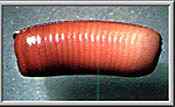
(German Cockroach)
This is the other cockroach which is arguably the most common in the U.K. but I would say that it all depends where you are in the country. Again they are found in the same places as the common cockroach, with one exception, these boys can walk across ceilings. Yep..!! better check that cup of tea just to see if there is anything floating in it. The other difference with this species is that the female carries the egg case (Oothecae) around with her until it is just due to hatch whereas the common cockroach is just that and dumps hers after a few hours. This insect was introduced from N.Africa. Both sexes can fly but are reluctant to do so. They are also sometimes called 'Steam Flies'.The German cockroach is light brown with two dark longitudinal stripes on the thorax. Adults are about 5/8-inch long and both sexes have fully developed wings. The number of eggs in the ootheca varies from 18 to 50 with a mean of 32, and the female carries the ootheca until shortly before hatching. Female German cockroaches may occasionally help the nymphs emerge from the egg capsule.
The average life cycle takes 60 days at room temperature. The German cockroach is the species most commonly found in households for several reasons: (1) it has a larger number of eggs per capsule, (2) nymphs reach sexual maturity more quickly than other cockroaches, (3) the female carries the egg capsule and protects the embryos until hatching, (4) German cockroaches are small and can conceal themselves easily, and (5) they can rapidly build up resistance to insecticides. This species is very active.
Both sexes are fully winged although they rarely fly. They're often carried from place to place in items such as bagged potatoes and onions, bottle cases and cartons and food packages. They travel readily from one location to another and pass through very small openings.
Places where German cockroaches are found often share many common characteristics; they'll usually be warm, dark, and have small cracks and crevices or other small openings into dark confined areas. Such places will generally be rather moist or located near water sources and food supplies.
German cockroaches usually cluster closely together. Adult female cockroaches with oothecae are found deeper within a harborage than other life stages. This makes it extremely difficult to eliminate this species unless extreme care is taken in thorough pesticide treatments. In populations which have developed pesticide resistance, individuals may scatter widely throughout a building. Although German cockroaches are normally most active at night in dark areas, people may see them out of their normal hiding places wherever they aren't disturbed.
A few interesting facts:-
So let's do a theoretical calculation based on the facts above:-
- These guys are 12 - 15 mm long
- They are coloured light brown with two dark stripes on the thorax.
- The wings are as long as the body, and overlap in both sexes.
- The oothecae is carried by the female until hatching is imminent.
- This young lady produces 4 - 8 oothecae in her lifetime.
- In this species, the oothecae contain 35 - 40 eggs.
- The hatching time is only one month.
- The nymph achieves adulthood in 5 - 7 moults, remember cockroaches don't pupate.
- The nymphal development can be as quick as 6 weeks, but can take up to 6 months.
Let us assume that the first female lays 1 oothecae, this will give us 40 eggs for arguments sake.
Say that there is plenty of food about and nymphal development is completed in 8 weeks and that 50% of these nymphs turn out to be females, let's say 20 females.
These females then lay 1 oothecae each.
This will give us 20 times 40 eggs which is 800.
Again there is plenty of food about and nymphal development is 8 weeks and again 50% are females.
These females lay 1 oothecae each.
This gives us 400 times 40 which is 16000
So after 9 months we have got sixteen thousand cockroaches, this assumes that none would die in development (mortality rate) but it does not take into account the fact that the original cockroaches would still be laying further oothecae and that these would be hatching and maturing.
There is of course a high mortality rate probably about 90%, and a good job too, but even so, if an infestation is not controlled it can very soon get out of hand.

German ootheca containing 35-40 nymphs